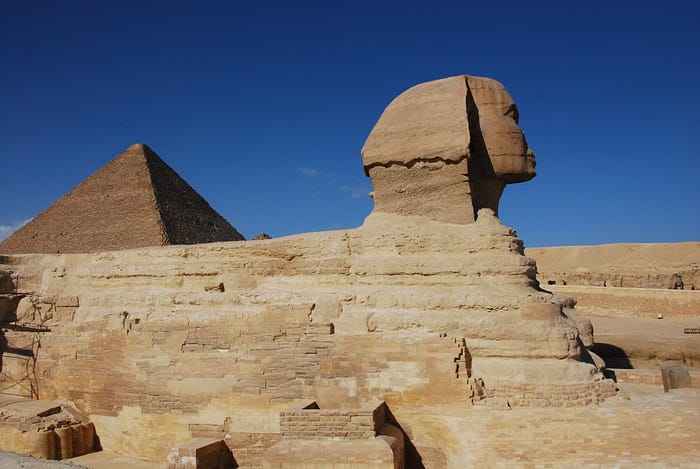In the timeless shadows of Egypt’s Giza Plateau stands an ancient sentinel that has mystified the world for millennia — the enigmatic and captivating Sphinx. This colossal monument, with the body of a lion and the regal countenance of a pharaoh, is more than just a relic of the past; it’s a symbol of human ingenuity and a gateway to a world of secrets and wonders waiting to be explored.

A Monument of Ageless Mystery
The Sphinx’s enigmatic allure lies not only in its grandeur but in the timeless secrets it guards. The very origins of this magnificent creature have eluded scholars and adventurers for centuries. Its construction during the reign of Pharaoh Khafre is the prevailing theory, but it poses more questions than answers.
Some believe that the Sphinx was meticulously carved to act as a guardian for the adjacent pyramids, a sentinel to watch over the sacred tombs of the pharaohs. Others propose that it was created for a deeper purpose, possibly rooted in religion or astronomical knowledge. This ageless enigma serves as a testament to the profound intellect and ingenuity of the ancient Egyptians, who left behind not only awe-inspiring architecture but also an enduring riddle for the ages.
For thousands of years, it has been a silent witness to the shifting sands of time, enduring desert winds, and the relentless gaze of the sun. The Sphinx’s undying presence mirrors the resilience of human history and our unyielding curiosity to unlock the mysteries of the past.

Noseless and Timeless
The Sphinx’s missing nose, with its fascinating backstory, has not only become a symbol of the monument but also a source of ongoing speculation and theories. While the erosion due to time and weather is the most widely accepted explanation, the legends surrounding Napoleon’s troops and other more eccentric conjectures add an extra layer of mystique to this ageless enigma.
The Erosion Hypothesis
The prevailing theory among scholars is that the Sphinx’s nose was eroded by the harsh desert climate over millennia. The intricate details of the face, particularly the nose, were carved from a softer limestone, which was more vulnerable to weathering. This gradual deterioration, rather than an abrupt act of vandalism, presents a testament to the enduring power of nature and time.
Napoleon’s Nose-Shooting Legend
Perhaps the most widely known legend surrounding the Sphinx’s missing nose is the story of Napoleon Bonaparte’s troops using it for target practice. Although no historical record substantiates this tale, it adds a fascinating layer of intrigue to the monument’s history. The image of soldiers firing at the nose of the Sphinx evokes a sense of mystery and adventure.
The Iconoclasts and Vandals
Beyond Napoleon’s soldiers, other theories suggest that ancient iconoclasts and vandals might have deliberately targeted the Sphinx’s face during various periods in history. While some evidence of defacement exists on other ancient Egyptian monuments, there’s limited proof to support these claims regarding the Sphinx.

The Dream Stela: A Portal to the Past
Nestled between the paws of this ancient guardian is the “Dream Stela,” a stone slab inscribed with the account of Thutmose IV. According to his tale, the Sphinx appeared to him in a dream, promising him the throne if he undertook its restoration. This story not only illustrates the Sphinx’s significance but also highlights the belief in the mystical powers it held over the ancient Egyptians.
Also, the Sphinx’s alignment with the pyramids has puzzled experts for centuries. Some believe it may hold astronomical or spiritual significance, possibly connected to the sun god Ra. This alignment reflects the meticulous precision of ancient Egyptian architecture, hinting at their advanced understanding of celestial movements.

A Subject of Debate
Throughout history, the Sphinx has been a topic of debate, speculation, and scholarly intrigue. Its gender remains disputed, with some asserting that it represents a female pharaoh, possibly Queen Hatshepsut, while others adhere to the conventional belief that it symbolizes Pharaoh Khafre.
The enigma of the Sphinx extends far beyond the Giza Plateau. Numerous replica Sphinxes can be found worldwide, from the Luxor Sphinx in Las Vegas to the Crystal Palace Sphinx in London. These replicas reflect the global fascination with this ancient marvel and its enduring cultural significance.

Unlocking the Mysteries
As we explore the captivating secrets of the Sphinx, we find a bridge connecting the past to the present. It’s a testament to human curiosity, innovation, and reverence for our ancestors. While the Sphinx’s mysteries may never be fully unraveled, they continue to inspire generations, encouraging us to seek knowledge, question the unknown, and marvel at the enduring power of human achievement.
Calling all content enthusiasts!
As a content creator on Medium.com, I face the challenge of minimal compensation for my hard work. However, your support can make a difference! If you find value in my articles, consider showing your appreciation on my “Buy Me a Coffee” page. Even a small contribution can fuel my passion for creating more meaningful content. Thank you for being a crucial part of my journey!


